-
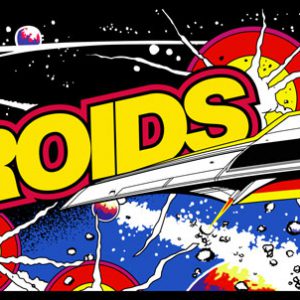 Yet another legendary, genre-defining game – in an era replete with genre-defining classics - in which a single player takes control of a ship trapped in the middle of an asteroid field. A number of large, slow-moving asteroids drift randomly around the play area and must be shot by the player. When shot, the asteroids will break into a number of smaller pieces, which must also be shot until, eventually, all of the asteroids and fragments will be destroyed and the next wave begins. Asteroids introduced real-world physics to video games for the first time, with speed and inertia all adding to the player’s problems. As well as the inertia of the player’s ship – forcing the player to allow for the ship slowing down and speeding up whenever the thrust button was utilized – shot asteroids would often send fragments flying in seemingly random directions, and at varying and unpredictable speeds. As well as the ever-present asteroids, alien saucers also make a regular appearance. These move diagonally around the screen, firing at the player’s ship and must be quickly destroyed.
Yet another legendary, genre-defining game – in an era replete with genre-defining classics - in which a single player takes control of a ship trapped in the middle of an asteroid field. A number of large, slow-moving asteroids drift randomly around the play area and must be shot by the player. When shot, the asteroids will break into a number of smaller pieces, which must also be shot until, eventually, all of the asteroids and fragments will be destroyed and the next wave begins. Asteroids introduced real-world physics to video games for the first time, with speed and inertia all adding to the player’s problems. As well as the inertia of the player’s ship – forcing the player to allow for the ship slowing down and speeding up whenever the thrust button was utilized – shot asteroids would often send fragments flying in seemingly random directions, and at varying and unpredictable speeds. As well as the ever-present asteroids, alien saucers also make a regular appearance. These move diagonally around the screen, firing at the player’s ship and must be quickly destroyed. -
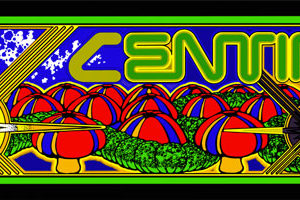 Centipede is a vertically oriented shoot ‘em up arcade game produced by Atari, Inc. in 1981. The game was designed by Ed Logg along with Dona Bailey, one of the few female game programmers in the industry at this time. It was also one of the first arcade coin-operated games to have a significant female player base, after Pac-Man. The player defends against centipedes, spiders, scorpions and fleas, completing a round after eliminating the centipede that winds down the playing field. The player is represented by a small, “somewhat humanoid head” at the bottom of the screen. The player moves the character about the bottom area of the screen with a trackball and fires laser shots at a centipede advancing from the top of the screen down through a field of mushrooms. Shooting any section of the centipede creates a mushroom; shooting one of the middle segments splits the centipede into two pieces at that point. Each piece then continues independently on its way down the board, with the first section of the rear piece becoming a new head. If the head is destroyed, the section behind it becomes the next head. The centipede starts at the top of the screen, traveling either left or right. When it hits a mushroom or the edge of the screen, it drops one level and switches direction. Thus, more mushrooms on the screen cause the centipede to descend more rapidly. The player can destroy mushrooms by shooting them, but each takes four hits to destroy. If the centipede reaches the bottom of the screen, it moves back and forth within the player area and one-segment “head” centipedes are periodically added. This continues until the player has eliminated both the original centipede and all heads. When all the centipede’s segments are destroyed, a new centipede forms at the top of the screen. Every time a centipede is eliminated, however, the next one is one segment shorter and is accompanied by one additional, fast-moving “head” centipede. A player loses a life when hit by a centipede or another enemy, such as a spider or a flea. The flea leaves mushrooms behind when fewer than five are in the player area, though the number required increases with level of difficulty. Spiders move across the player area in a zig-zag fashion and occasionally eat some of the mushrooms. Scorpions poison every mushroom they touch, but these never appear in the player’s movement region. A centipede touching a poisoned mushroom hurtles straight toward the player’s area. Upon reaching the player’s area, the centipede returns to normal behavior.
Centipede is a vertically oriented shoot ‘em up arcade game produced by Atari, Inc. in 1981. The game was designed by Ed Logg along with Dona Bailey, one of the few female game programmers in the industry at this time. It was also one of the first arcade coin-operated games to have a significant female player base, after Pac-Man. The player defends against centipedes, spiders, scorpions and fleas, completing a round after eliminating the centipede that winds down the playing field. The player is represented by a small, “somewhat humanoid head” at the bottom of the screen. The player moves the character about the bottom area of the screen with a trackball and fires laser shots at a centipede advancing from the top of the screen down through a field of mushrooms. Shooting any section of the centipede creates a mushroom; shooting one of the middle segments splits the centipede into two pieces at that point. Each piece then continues independently on its way down the board, with the first section of the rear piece becoming a new head. If the head is destroyed, the section behind it becomes the next head. The centipede starts at the top of the screen, traveling either left or right. When it hits a mushroom or the edge of the screen, it drops one level and switches direction. Thus, more mushrooms on the screen cause the centipede to descend more rapidly. The player can destroy mushrooms by shooting them, but each takes four hits to destroy. If the centipede reaches the bottom of the screen, it moves back and forth within the player area and one-segment “head” centipedes are periodically added. This continues until the player has eliminated both the original centipede and all heads. When all the centipede’s segments are destroyed, a new centipede forms at the top of the screen. Every time a centipede is eliminated, however, the next one is one segment shorter and is accompanied by one additional, fast-moving “head” centipede. A player loses a life when hit by a centipede or another enemy, such as a spider or a flea. The flea leaves mushrooms behind when fewer than five are in the player area, though the number required increases with level of difficulty. Spiders move across the player area in a zig-zag fashion and occasionally eat some of the mushrooms. Scorpions poison every mushroom they touch, but these never appear in the player’s movement region. A centipede touching a poisoned mushroom hurtles straight toward the player’s area. Upon reaching the player’s area, the centipede returns to normal behavior. -
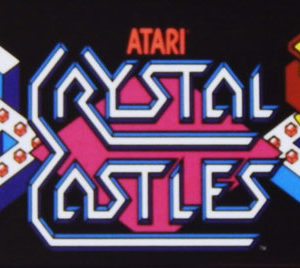 Crystal Castles has nine levels with four castles each, and a tenth level which features a single castle — the clearing of which ends the game. Each of the 37 trimetric-projected castles consists of a maze of hallways filled with gems and bonus objects, and also includes stairs, elevators and tunnels that the player can use as shortcuts. The three-letter initials of the player with the highest score are used to form the first level’s castle structure. When all gems in a castle have been collected, the player moves on to the next castle. The player can also skip some castles and acquire additional lives and points by using secret warps activated by making Bentley Bear jump at special locations. A trackball and “jump” button are used for controlling Bentley Bear’s motions. Gems are collected by simply walking over them, and a bonus is given upon collection of the last gem. While collecting gems, there are a number of enemies that try to stop Bentley and/or collect the gems for themselves. With two exceptions, if touched by the enemies he will lose one of his lives. Any gems collected by the enemies also result in a lower obtainable score for that screen. Likewise, if the last available gem is collected by the enemy, the player also loses the last gem bonus. Enemies can be avoided by use of the maze and its constructs, or by making Bentley jump over opponents with the jump button, in some cases also allowing him to stun them. Some types of enemies will track Bentley’s movements in certain ways, while others move at random. If Bentley is touched, he “cries out” in a distinctive manner with the use of a cartoonish word balloons. If 3 or more lives remain, he says “BYE!”; if 2 lives still remain, the quotation is “OH NO!”; if 1 life is left, it is “OUCH!”; and finally, for the last lost life (which ends the game), he says “#?!”, so as to imitate an obscenity. At the beginning of every maze, gems are worth 1 point each; this value increases by 1 for every gem Bentley picks up, to a maximum of 99. Each maze also randomly includes a hat or honey pot, which serve the dual purpose of awarding points and providing Bentley with the ability to defeat specific enemies. The hat is worth 500 points and will make Bentley invulnerable for a few seconds and allow him to eliminate Berthilda the witch, who appears in the last maze of each level. The honey pot is worth 1,000 points, and picking it up can delay the landing of a swarm of bees. Other villains present in the game include: “Nasty Trees” which become more ornery as levels progress, a ghost that will usually appear in the Hidden Spiral levels, dancing skeletons, “Gem Eaters” who Bentley Bear can defeat if he catches them while eating a gem, and also the devilish “Crystal Balls” creatures that in later levels tend to follow Bentley Bear persistently as he collects gems. The Nasty Trees and Crystal Balls can also pick up gems. Crystal Castles contains two notable easter eggs. Jumping 100 times or more in the southeast corner of level 1?1 and clearing the maze of all gems will make ATARI appear on level 1?2.[2] On level 5?4, if the player kills Berthilda and goes to the corner of the area where she was and jumps, “FXL” will appear in the southeast corner of the screen. These are the initials for Franz X. Lanzinger, a designer of Crystal Castles.
Crystal Castles has nine levels with four castles each, and a tenth level which features a single castle — the clearing of which ends the game. Each of the 37 trimetric-projected castles consists of a maze of hallways filled with gems and bonus objects, and also includes stairs, elevators and tunnels that the player can use as shortcuts. The three-letter initials of the player with the highest score are used to form the first level’s castle structure. When all gems in a castle have been collected, the player moves on to the next castle. The player can also skip some castles and acquire additional lives and points by using secret warps activated by making Bentley Bear jump at special locations. A trackball and “jump” button are used for controlling Bentley Bear’s motions. Gems are collected by simply walking over them, and a bonus is given upon collection of the last gem. While collecting gems, there are a number of enemies that try to stop Bentley and/or collect the gems for themselves. With two exceptions, if touched by the enemies he will lose one of his lives. Any gems collected by the enemies also result in a lower obtainable score for that screen. Likewise, if the last available gem is collected by the enemy, the player also loses the last gem bonus. Enemies can be avoided by use of the maze and its constructs, or by making Bentley jump over opponents with the jump button, in some cases also allowing him to stun them. Some types of enemies will track Bentley’s movements in certain ways, while others move at random. If Bentley is touched, he “cries out” in a distinctive manner with the use of a cartoonish word balloons. If 3 or more lives remain, he says “BYE!”; if 2 lives still remain, the quotation is “OH NO!”; if 1 life is left, it is “OUCH!”; and finally, for the last lost life (which ends the game), he says “#?!”, so as to imitate an obscenity. At the beginning of every maze, gems are worth 1 point each; this value increases by 1 for every gem Bentley picks up, to a maximum of 99. Each maze also randomly includes a hat or honey pot, which serve the dual purpose of awarding points and providing Bentley with the ability to defeat specific enemies. The hat is worth 500 points and will make Bentley invulnerable for a few seconds and allow him to eliminate Berthilda the witch, who appears in the last maze of each level. The honey pot is worth 1,000 points, and picking it up can delay the landing of a swarm of bees. Other villains present in the game include: “Nasty Trees” which become more ornery as levels progress, a ghost that will usually appear in the Hidden Spiral levels, dancing skeletons, “Gem Eaters” who Bentley Bear can defeat if he catches them while eating a gem, and also the devilish “Crystal Balls” creatures that in later levels tend to follow Bentley Bear persistently as he collects gems. The Nasty Trees and Crystal Balls can also pick up gems. Crystal Castles contains two notable easter eggs. Jumping 100 times or more in the southeast corner of level 1?1 and clearing the maze of all gems will make ATARI appear on level 1?2.[2] On level 5?4, if the player kills Berthilda and goes to the corner of the area where she was and jumps, “FXL” will appear in the southeast corner of the screen. These are the initials for Franz X. Lanzinger, a designer of Crystal Castles. -
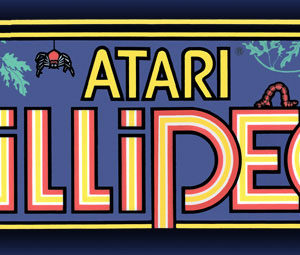 Similar to Centipede, the object of the game is to destroy a millipede that advances downward from the top of the screen. The millipede travels horizontally until it either hits an obstacle or reaches the edge of the screen, after which it drops one row and reverses direction. Once it enters the player’s gray maneuvering area, it stays there and extra heads appear at intervals until both they and the millipede are destroyed. Shooting a body segment splits the millipede in two, with the rear portion sprouting its own head. A collision with any enemy costs the player one life. New enemies and gameplay elements are introduced in Millipede: Earwig: same as the scorpion in Centipede, making mushrooms poisonous so that the millipede will charge straight to the bottom of the screen after touching them. Bee: same as the flea in Centipede, dropping mushrooms in a vertical line and requiring two shots to kill. Spider: same behavior as in Centipede, bouncing irregularly across the player area and eating mushrooms. Multiple spiders can appear at the same time on higher levels. Inchworm: when hit, slows all enemies for a short period of time. Beetle: crawls around the player area for a while, then climbs up and leaves the screen, turning any mushrooms it touches into indestructible flowers. When hit, everything on the screen scrolls down one row. Dragonfly: drops mushrooms while zigzagging down, and can be destroyed with a single shot. Mosquito: bounces off the sides of the screen as it descends diagonally. When hit, everything on the screen scrolls up one row. DDT bomb (stationary): can be blown up with one shot, destroying all enemies and mushrooms within the blast radius. Whenever the mushrooms scroll down, a new bomb is added at the top of the screen. Up to four bombs can be in play at one time. The player scores points for shooting the bomb itself, as well as increased values for any enemies destroyed in the blast. All flowers and poisoned/partially destroyed mushrooms revert to normal, whole mushrooms and score points during the process when the player loses a life. At regular intervals during the game, the player will face a swarm of enemies (bees, dragonflies, etc.) instead of the usual millipede. Each enemy destroyed awards increasing points, up to a maximum of 1,000 points per enemy; this attack ends when either the entire swarm has passed or the player loses a life. Also, at intervals new mushrooms will grow on the field while others die off, in a pattern similar to Conway’s Game of Life. Players can also choose at the start of the game whether to play at an advanced level, starting with a score that is a multiple of the number of points needed to earn an extra life (by default, 15,000). The gameplay is generally much more advanced than it would be had the player started with a score of 0 and worked their way up to that point level. The maximum advanced level allowed is a function of the preceding player’s score, and games started at an advanced level where the player did not earn at least one extra life are not eligible for the high scoreboard.
Similar to Centipede, the object of the game is to destroy a millipede that advances downward from the top of the screen. The millipede travels horizontally until it either hits an obstacle or reaches the edge of the screen, after which it drops one row and reverses direction. Once it enters the player’s gray maneuvering area, it stays there and extra heads appear at intervals until both they and the millipede are destroyed. Shooting a body segment splits the millipede in two, with the rear portion sprouting its own head. A collision with any enemy costs the player one life. New enemies and gameplay elements are introduced in Millipede: Earwig: same as the scorpion in Centipede, making mushrooms poisonous so that the millipede will charge straight to the bottom of the screen after touching them. Bee: same as the flea in Centipede, dropping mushrooms in a vertical line and requiring two shots to kill. Spider: same behavior as in Centipede, bouncing irregularly across the player area and eating mushrooms. Multiple spiders can appear at the same time on higher levels. Inchworm: when hit, slows all enemies for a short period of time. Beetle: crawls around the player area for a while, then climbs up and leaves the screen, turning any mushrooms it touches into indestructible flowers. When hit, everything on the screen scrolls down one row. Dragonfly: drops mushrooms while zigzagging down, and can be destroyed with a single shot. Mosquito: bounces off the sides of the screen as it descends diagonally. When hit, everything on the screen scrolls up one row. DDT bomb (stationary): can be blown up with one shot, destroying all enemies and mushrooms within the blast radius. Whenever the mushrooms scroll down, a new bomb is added at the top of the screen. Up to four bombs can be in play at one time. The player scores points for shooting the bomb itself, as well as increased values for any enemies destroyed in the blast. All flowers and poisoned/partially destroyed mushrooms revert to normal, whole mushrooms and score points during the process when the player loses a life. At regular intervals during the game, the player will face a swarm of enemies (bees, dragonflies, etc.) instead of the usual millipede. Each enemy destroyed awards increasing points, up to a maximum of 1,000 points per enemy; this attack ends when either the entire swarm has passed or the player loses a life. Also, at intervals new mushrooms will grow on the field while others die off, in a pattern similar to Conway’s Game of Life. Players can also choose at the start of the game whether to play at an advanced level, starting with a score that is a multiple of the number of points needed to earn an extra life (by default, 15,000). The gameplay is generally much more advanced than it would be had the player started with a score of 0 and worked their way up to that point level. The maximum advanced level allowed is a function of the preceding player’s score, and games started at an advanced level where the player did not earn at least one extra life are not eligible for the high scoreboard. -
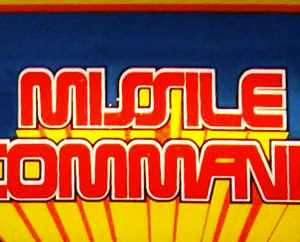 Missile Command is a 1980 arcade game by Atari, Inc. that was also licensed to Sega for European release. It is considered one of the most notable games from the Golden Age of Video Arcade Games. The plot of Missile Command is simple: the player’s six cities are being attacked by an endless hail of ballistic missiles, some of them even splitting like multiple independently targetable reentry vehicles (MIRVs), and in later levels smart bombs which can evade a less than perfectly targeted missile. As a regional commander of three anti-missile batteries, the player must defend six cities in their zone from being destroyed. The game is played by moving a crosshair across the sky background via a trackball and pressing one of three buttons to launch a counter-missile from the appropriate battery. Counter-missiles explode upon reaching the crosshair, leaving a fireball that persists for several seconds and destroys any enemy missiles that enter it. There are three batteries, each with ten missiles; a missile battery becomes useless when all its missiles are fired, or if the battery is destroyed by enemy fire. The missiles of the central battery fly to their targets at much greater speed; only these missiles can effectively kill a smart bomb at a distance. The game is staged as a series of levels of increasing difficulty; each level contains a set number of incoming enemy weapons. The weapons attack the six cities, as well as the missile batteries; being struck by an enemy weapon results in destruction of the city or missile battery. Enemy weapons are only able to destroy 3 cities during one level. A level ends if all the cities are destroyed, or when all enemy weaponry is destroyed or reaches its target. A player who runs out of missiles no longer has control over the remainder of the level. At the conclusion of a level, the player receives bonus points for any remaining cities or unused missiles. Between levels missile batteries are rebuilt and replenished; destroyed cities are rebuilt only at set point levels (usually 10 or 12K). The game inevitably ends when all six cities have been wiped out. Like most early arcade games, there is no way to “win” the game; the game just keeps going with ever faster and more prolific incoming missiles. The game, then, is just a contest in seeing how long the player can survive. On conclusion of the game, the screen displays “The End”, perhaps a poke at oncoming Nuclear Holocaust rather than the standard “Game Over” text (however, if the player is able to make the high score list, the game then prompts the player to enter his/her initials, with the “The End” sequence skipped). The game features an interesting bug: once a score of 810,000 is reached, a large number of cities are awarded (176 cities plus the continuing accrual of bonus cities) and it is possible to carry on playing for several hours. At some later stage the speed of missiles increases greatly for a few screens. On the 255th and 256th yellow screens, known as the 0x stages, the scoring increases by 256 times the base value. For good players these two 0x stages could earn over a million points. This enabled them to reach a score of approximately 2,800,000 (although only 6 digit scores were shown, so it would display 800,000) and at this point the accelerated rate would suddenly cease and the game would restart at its original (slow) speed and return to the first stage, but with the score and any saved cities retained. In this way it was possible to play this game for hours on end. Targeting crosshair: Aim your missiles quickly but carefully. Use the trackball to move the targeting crosshair to where you want the next missile to go, then press any Launch Control button to fire the missile. The missile will explode where the crosshair was positioned when the Launch Control button was pressed. Cities: There are six cities in total on the screen at one time, three on either side of the Delta Base. If one enemy missile or Smart Bomb manages to strike a city, that city will be wiped out. When all cities are destroyed, the game is over. Alpha Base: The missile base on the left side of the screen. Press the leftmost Launch Control button to launch an ABM from the Alpha Base. Delta Base: The missile base in the center of the screen. Press the middle Launch Control button to launch an ABM from the Delta Base. Omega Base: The missile base on the right side of the screen. Press the rightmost Launch Control button to launch an ABM from the Omega Base. NOTE: The Alpha and Omega Bases launch ABMs at a slower speed than the Delta Base, so you must plan further ahead when launching missiles from those bases. Defensive Missiles : The ABMs you launch to protect your cities. Each missile base contains 10 ABMs per wave. If any missile base is struck by an attack missile or smart bomb, the remaining stock of missiles for that wave are destroyed, and the missile base is rendered useless until the next wave. You receive bonus points for every ABM you have remaining at the end of each wave. Attack Missiles : Their only aim is to destroy your cities and missile bases. Every missile wave starts off with a hailstorm of attack missiles. They never deviate from their path. They may, however, turn into MIRVs. MIRV : Surprise! There is no warning when an attack missile turns into an MIRV (with multiple warheads). Think fast. Each new missile that the MIRV unleashes is carefully targeted. Killer Satellite: A mean-looking satellite that travels across the sky at a mid-level altitude and fires attack missiles. First appears in Wave 2. Bomber: A big slow-moving target that flies across the sky at a mid-level altitude, but watch out! It fires attack missiles. First appears in Wave 2. WARNING: If you destory a bomber or killer satellite before they deploy their missiles, you may see their missiles added to the downpour. An existing missile may also turn into an MIRV. Smart Bomb: Smart enough to avoid most explosion clouds from your ABMs. Your ABM must explode next to one in order to destroy it. You can also squeen it between two explosions to destroy it. First appears in Wave 5. ‘LOW’ Warning: As soon as there are only three ABMs left in a missile base, the game displays the word “LOW” underneath that base, and a warning signal sounds. Heed the warning.
Missile Command is a 1980 arcade game by Atari, Inc. that was also licensed to Sega for European release. It is considered one of the most notable games from the Golden Age of Video Arcade Games. The plot of Missile Command is simple: the player’s six cities are being attacked by an endless hail of ballistic missiles, some of them even splitting like multiple independently targetable reentry vehicles (MIRVs), and in later levels smart bombs which can evade a less than perfectly targeted missile. As a regional commander of three anti-missile batteries, the player must defend six cities in their zone from being destroyed. The game is played by moving a crosshair across the sky background via a trackball and pressing one of three buttons to launch a counter-missile from the appropriate battery. Counter-missiles explode upon reaching the crosshair, leaving a fireball that persists for several seconds and destroys any enemy missiles that enter it. There are three batteries, each with ten missiles; a missile battery becomes useless when all its missiles are fired, or if the battery is destroyed by enemy fire. The missiles of the central battery fly to their targets at much greater speed; only these missiles can effectively kill a smart bomb at a distance. The game is staged as a series of levels of increasing difficulty; each level contains a set number of incoming enemy weapons. The weapons attack the six cities, as well as the missile batteries; being struck by an enemy weapon results in destruction of the city or missile battery. Enemy weapons are only able to destroy 3 cities during one level. A level ends if all the cities are destroyed, or when all enemy weaponry is destroyed or reaches its target. A player who runs out of missiles no longer has control over the remainder of the level. At the conclusion of a level, the player receives bonus points for any remaining cities or unused missiles. Between levels missile batteries are rebuilt and replenished; destroyed cities are rebuilt only at set point levels (usually 10 or 12K). The game inevitably ends when all six cities have been wiped out. Like most early arcade games, there is no way to “win” the game; the game just keeps going with ever faster and more prolific incoming missiles. The game, then, is just a contest in seeing how long the player can survive. On conclusion of the game, the screen displays “The End”, perhaps a poke at oncoming Nuclear Holocaust rather than the standard “Game Over” text (however, if the player is able to make the high score list, the game then prompts the player to enter his/her initials, with the “The End” sequence skipped). The game features an interesting bug: once a score of 810,000 is reached, a large number of cities are awarded (176 cities plus the continuing accrual of bonus cities) and it is possible to carry on playing for several hours. At some later stage the speed of missiles increases greatly for a few screens. On the 255th and 256th yellow screens, known as the 0x stages, the scoring increases by 256 times the base value. For good players these two 0x stages could earn over a million points. This enabled them to reach a score of approximately 2,800,000 (although only 6 digit scores were shown, so it would display 800,000) and at this point the accelerated rate would suddenly cease and the game would restart at its original (slow) speed and return to the first stage, but with the score and any saved cities retained. In this way it was possible to play this game for hours on end. Targeting crosshair: Aim your missiles quickly but carefully. Use the trackball to move the targeting crosshair to where you want the next missile to go, then press any Launch Control button to fire the missile. The missile will explode where the crosshair was positioned when the Launch Control button was pressed. Cities: There are six cities in total on the screen at one time, three on either side of the Delta Base. If one enemy missile or Smart Bomb manages to strike a city, that city will be wiped out. When all cities are destroyed, the game is over. Alpha Base: The missile base on the left side of the screen. Press the leftmost Launch Control button to launch an ABM from the Alpha Base. Delta Base: The missile base in the center of the screen. Press the middle Launch Control button to launch an ABM from the Delta Base. Omega Base: The missile base on the right side of the screen. Press the rightmost Launch Control button to launch an ABM from the Omega Base. NOTE: The Alpha and Omega Bases launch ABMs at a slower speed than the Delta Base, so you must plan further ahead when launching missiles from those bases. Defensive Missiles : The ABMs you launch to protect your cities. Each missile base contains 10 ABMs per wave. If any missile base is struck by an attack missile or smart bomb, the remaining stock of missiles for that wave are destroyed, and the missile base is rendered useless until the next wave. You receive bonus points for every ABM you have remaining at the end of each wave. Attack Missiles : Their only aim is to destroy your cities and missile bases. Every missile wave starts off with a hailstorm of attack missiles. They never deviate from their path. They may, however, turn into MIRVs. MIRV : Surprise! There is no warning when an attack missile turns into an MIRV (with multiple warheads). Think fast. Each new missile that the MIRV unleashes is carefully targeted. Killer Satellite: A mean-looking satellite that travels across the sky at a mid-level altitude and fires attack missiles. First appears in Wave 2. Bomber: A big slow-moving target that flies across the sky at a mid-level altitude, but watch out! It fires attack missiles. First appears in Wave 2. WARNING: If you destory a bomber or killer satellite before they deploy their missiles, you may see their missiles added to the downpour. An existing missile may also turn into an MIRV. Smart Bomb: Smart enough to avoid most explosion clouds from your ABMs. Your ABM must explode next to one in order to destroy it. You can also squeen it between two explosions to destroy it. First appears in Wave 5. ‘LOW’ Warning: As soon as there are only three ABMs left in a missile base, the game displays the word “LOW” underneath that base, and a warning signal sounds. Heed the warning. -
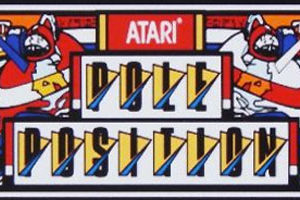 Gameplay of Pole Position. In this game, the player controls a Formula One race car, and has to complete a time trial lap within a certain amount of time (between 90 and 120 seconds) to qualify for an F1 race at the Fuji Racetrack. After qualifying, the player races against seven other CPU-controlled cars in a championship race (but if he or she does not qualify, the car will stay on the track until the timer runs out). The player must also avoid going off the road so that he or she will not crash into the billboards. Pole Position was the first racing video game to feature a track based on a real racing circuit. It was also the first game to feature a qualifying lap, requiring the player to complete a time trial before they can compete in Grand Prix races. Once the player has qualified, they must complete the race in the time allowed, avoiding collisions with CPU-controlled opponents and billboards along the sides of the track. The game’s publisher Atari publicized the game for its “unbelievable driving realism” in providing a Formula 1 experience behind a racing wheel. The game’s graphics featured full-color landscapes with scaling sprites, including race cars and other signs, and a pseudo-3D, third-person, rear perspective view of the track, with its vanishing point swaying side to side as the player approaches corners, accurately simulating forward movement into the distance.
Gameplay of Pole Position. In this game, the player controls a Formula One race car, and has to complete a time trial lap within a certain amount of time (between 90 and 120 seconds) to qualify for an F1 race at the Fuji Racetrack. After qualifying, the player races against seven other CPU-controlled cars in a championship race (but if he or she does not qualify, the car will stay on the track until the timer runs out). The player must also avoid going off the road so that he or she will not crash into the billboards. Pole Position was the first racing video game to feature a track based on a real racing circuit. It was also the first game to feature a qualifying lap, requiring the player to complete a time trial before they can compete in Grand Prix races. Once the player has qualified, they must complete the race in the time allowed, avoiding collisions with CPU-controlled opponents and billboards along the sides of the track. The game’s publisher Atari publicized the game for its “unbelievable driving realism” in providing a Formula 1 experience behind a racing wheel. The game’s graphics featured full-color landscapes with scaling sprites, including race cars and other signs, and a pseudo-3D, third-person, rear perspective view of the track, with its vanishing point swaying side to side as the player approaches corners, accurately simulating forward movement into the distance. -

-
 Atari PONG was released in June 1972 and is the first commercially successful video game and is based on a simple two-dimensional graphical representation of a tennis-like game. Players use paddles to hit a ball back and forth on a black and white screen. Pong was the first game developed by Atari Inc., by Nolan Bushnell and Ted Dabney. Pong (marketed as PONG) is one of the earliest arcade video games, and is a tennis sports game featuring simple two-dimensional graphics. The player controls an in-game paddle by moving it vertically across the left side of the screen, and can compete against either a computer controlled opponent or another player controlling a second paddle on the opposing side. Players use the paddles to hit a ball back and forth. The aim is for a player to earn more points than the opponent; points are earned when one fails to return the ball to the other. Pong consistently earned four times more revenue than other coin-operated machines, which resulted in an increase in the number of orders Atari received. This provided Atari with a steady source of income; the company sold the machines at three times the cost of production. By 1973, the company had filled 2,500 orders, and, at the end of 1974, sold more than 8,000 units.[20] The arcade cabinets have since become collector’s items with the cocktail-table version being the rarest. Atari eventually sold more than 35,000 units, however, many more imitations were produced by competitors.
Atari PONG was released in June 1972 and is the first commercially successful video game and is based on a simple two-dimensional graphical representation of a tennis-like game. Players use paddles to hit a ball back and forth on a black and white screen. Pong was the first game developed by Atari Inc., by Nolan Bushnell and Ted Dabney. Pong (marketed as PONG) is one of the earliest arcade video games, and is a tennis sports game featuring simple two-dimensional graphics. The player controls an in-game paddle by moving it vertically across the left side of the screen, and can compete against either a computer controlled opponent or another player controlling a second paddle on the opposing side. Players use the paddles to hit a ball back and forth. The aim is for a player to earn more points than the opponent; points are earned when one fails to return the ball to the other. Pong consistently earned four times more revenue than other coin-operated machines, which resulted in an increase in the number of orders Atari received. This provided Atari with a steady source of income; the company sold the machines at three times the cost of production. By 1973, the company had filled 2,500 orders, and, at the end of 1974, sold more than 8,000 units.[20] The arcade cabinets have since become collector’s items with the cocktail-table version being the rarest. Atari eventually sold more than 35,000 units, however, many more imitations were produced by competitors. -
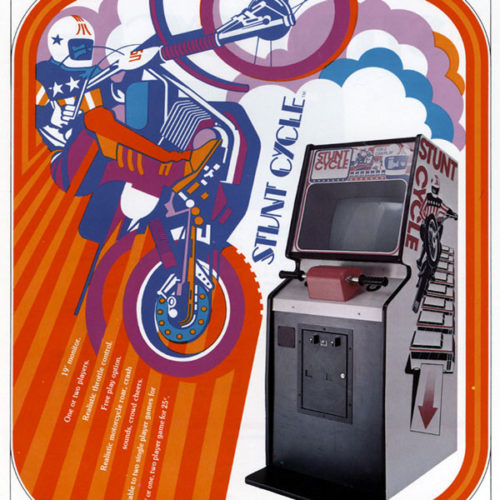
-
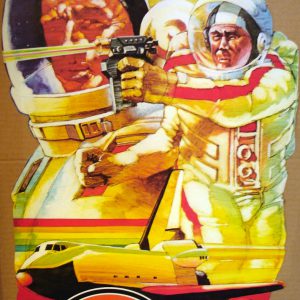 Move a paddle back and forth at the bottom of the screen to rebound a ball back into a brick wall, knocking bricks out one by one. There are three separate games: double — same as Breakout, knock down bricks and when they are all gone a new wall forms cavity — two other balls are inside the wall, when they have an escape route you can hit them as well progressive — as the wall is destroyed, new bricks are added and the entire wall shifts down toward your paddle. The sound effects are just simple beeps. This video game is a typical late ’70s machine which has been reproduced in many variations as well as downloaded apps on smartphones today. No complicated rules here, which is why it was so popular in its glory days. You control the horizontal paddle at the bottom of the playfield and, through the use of the spin controller, try to prevent losing the “ball” below the paddle. By aiming at the bricks, you try to hit all of them and then “break through” to the next layer of bricks. This accomplishment is rewarded with a period of high scoring and ricocheting video bounces of the “ball” until it escapes the brick layer and comes into your paddle again. These brick layers then start to drop toward your paddle. By the way, the TV is black and white!
Move a paddle back and forth at the bottom of the screen to rebound a ball back into a brick wall, knocking bricks out one by one. There are three separate games: double — same as Breakout, knock down bricks and when they are all gone a new wall forms cavity — two other balls are inside the wall, when they have an escape route you can hit them as well progressive — as the wall is destroyed, new bricks are added and the entire wall shifts down toward your paddle. The sound effects are just simple beeps. This video game is a typical late ’70s machine which has been reproduced in many variations as well as downloaded apps on smartphones today. No complicated rules here, which is why it was so popular in its glory days. You control the horizontal paddle at the bottom of the playfield and, through the use of the spin controller, try to prevent losing the “ball” below the paddle. By aiming at the bricks, you try to hit all of them and then “break through” to the next layer of bricks. This accomplishment is rewarded with a period of high scoring and ricocheting video bounces of the “ball” until it escapes the brick layer and comes into your paddle again. These brick layers then start to drop toward your paddle. By the way, the TV is black and white!